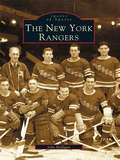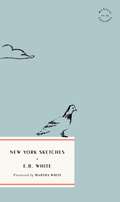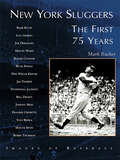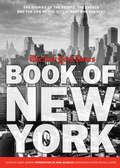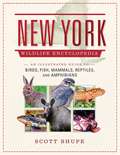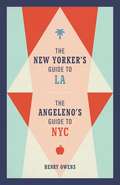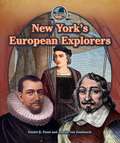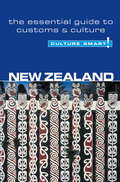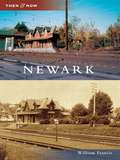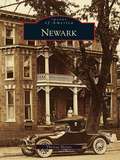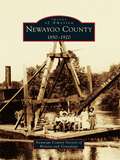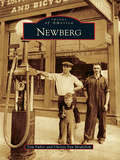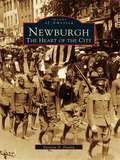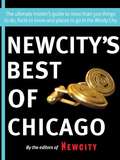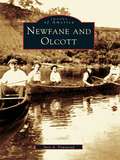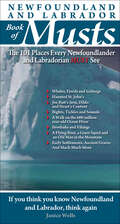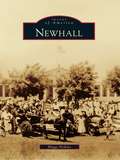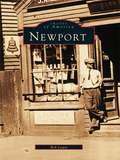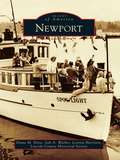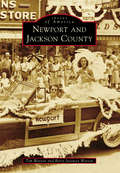- Table View
- List View
New York Rangers, The (Images of Sports)
by John HalliganFor more than three quarters of a century, the New York Rangers have been delighting hockey fans-New Yorkers and suburbanites alike-with a classy brand of entertainment that has no equal. The team's history includes four Stanley Cups, scores of individual stars, and countless magic moments. All of the excitement and drama of these triumphs is captured in The New York Rangers. This book salutes not only the Rangers' tradition of excellence but also the masterful talents of the photojournalists who have chronicled the team since its birth in 1926.
New York Sketches (McNally Editions)
by E.B. WhiteE. B. White&’s greatest stories, asides, essays, jokes, and tall tales about the city he arguably saw clearest, loved best, and skewered most mercilessly.Over more than fifty years at the New Yorker, E. B. White came to define a kind of ideal American prose: clear, casual, democratic, and urbane. He also did more than any writer to define his favorite city. His classic Here Is New York captured a moment in the life of Manhattan with precision and love—but his was no fleeting infatuation. In New York Sketches, the first collection of his casual pieces about the city, White ranges at whim from the nesting habits of pigeons to the aisles of a calculator trade-show on Eighth Avenue, from the behavior of snails in aquariums to the ghosts of old romance that haunt a flower shop or a fire escape or an old hotel. These sketches, some less than a page long, many written for a laugh, or in response to the news of the day, show us White at his most playful and inventive. New York Sketches is a welcome diversion for every New Yorker—native, adoptive, or far from home—and a perfect introduction, not only to what White called &“the inscrutable and lovely town,&” but to the everyday enchantments of one of her fondest reporters.
New York Sluggers: The First 75 Years (Images of Baseball)
by Mark RuckerNew York City was the original hotbed of baseball, so it is not surprising that fans in the five boroughs are very knowledgeable about the game. It did not take long after baseball was established in the city in the late 1850s for heavy hitters to rise in popularity. New York has continued to set the standard. When thinking about hitting, or better yet, smashing or crushing a baseball, the first team to come to mind is always the New York Yankees. Slugging was actually invented by the Yanks and was most prominently demonstrated by Babe Ruth. When Lou Gehrig joined the team in 1923, a one-two punch was established that set a standard seldom equaled in major-league history. Meanwhile, across the East River, the Giants manufactured lots of hitting, and the New York Nationals rattled the walls in the Polo Grounds. This book is a pictorial story of the sluggers that made history in New York, in both the American and National Leagues.
New York Stories: The Best of the City Section of the New York Times
by Constance RosenblumThese forty essays from the New York Times&’ City section tell &“stories of human life in all its quirky richness&” (The Boston Globe). Featuring a cast of stellar writers, this collection brings some of the best essays from the City section to readers beyond the five boroughs. New York Stories profiles people like sixteen-year-old Barbara Ott, who surfs the waters off Rockaway in Queens, and Sonny Payne, the beloved panhandler of the F train. Other essays explore memorable places, from the Greenwich Village townhouse blown up by radical activists in the 1970s to a basketball court that serves as the heart of its Downtown neighborhood. The forty essays collected here reflect an intimate understanding of the city, one that goes beyond the headlines. The result is a passionate, well-written portrait of a legendary and ever-evolving place. Contributors include: Andre Aciman, Thomas Beller, Laura Shaine Cunningham, Jim Dwyer, Jill Eisenstadt, Vivian Gornick, Chuck Klosterman, Robert Lipsyte, Phillip Lopate, Jan Morris, Richard Price, Joe Queenan, Suzanne Vega, Meg Wolitzer, and more &“Unassuming, elegant dispatches, suffused with a wise but unsentimental affection.&”—The New Yorker &“All of the pieces are engrossing . . . This is both an excellent addition to New York history and a pleasure for casual browsing.&” ―Publishers Weekly
New York Through the Lens
by Vivienne GucwaStreet photographers will never tire of New York as a subject. It is the perfect setting for the genre, the world's most evocative cityscape, against which candid, memorable moments play themselves out every day. Nearly a decade ago, Vivienne Gucwa began walking the streets of the city with the only camera she could afford a sub-$100 point-and-shoot and started taking pictures. Choosing a direction and going as far as her feet would take her, she noticed lines, forms and structures that had previously gone unnoticed but which resonated, embodying a sense of home. Having limited equipment forced her to learn about light, composition and colour, and her burgeoning talent won her blog millions of readers and wide recognition in the photographic community. New York Through the Lens showcases the stunning results of her ongoing quest. Filled with spectacular photographs and illuminated by Vivienne's own insightful commentary, NY Through the Lens acts as a beautiful travel guide to the city; it will be a must-read for her many fans and for any lover of street photography.
New York Through the Lens
by Vivienne GucwaStreet photographers will never tire of New York as a subject. It is the perfect setting for the genre, the world's most evocative cityscape, against which candid, memorable moments play themselves out every day. Nearly a decade ago, Vivienne Gucwa began walking the streets of the city with the only camera she could afford a sub-$100 point-and-shoot and started taking pictures. Choosing a direction and going as far as her feet would take her, she noticed lines, forms and structures that had previously gone unnoticed but which resonated, embodying a sense of home. Having limited equipment forced her to learn about light, composition and colour, and her burgeoning talent won her blog millions of readers and wide recognition in the photographic community. New York Through the Lens showcases the stunning results of her ongoing quest. Filled with spectacular photographs and illuminated by Vivienne's own insightful commentary, NY Through the Lens acts as a beautiful travel guide to the city; it will be a must-read for her many fans and for any lover of street photography.
The New York Times: From Ferrante's Naples to Hammett's San Francisco, Literary Pilgrimages Around the World
by New York TimesA curated collection of the New York Times' travel column, "Footsteps," exploring iconic authors' relationships to landmarks and cities around the world Before Nick Carraway was drawn into Daisy and Gatsby’s sparkling, champagne-fueled world in The Great Gatsby, F. Scott Fitzgerald vacationed in the French Riviera, where a small green lighthouse winked at ships on the horizon. Before the nameless lovers began their illicit affair in The Lover, Marguerite Duras embarked upon her own scandalous relationship amidst the urban streets of Saigon. And before readers were terrified by a tentacled dragon-man called Cthulhu, H.P. Lovecraft was enthralled by the Industrial Trust tower-- the 26-story skyscraper that makes up the skyline of Providence, Rhode Island. Based on the popular New York Times travel column, Footsteps is an anthology of literary pilgrimages, exploring the geographic muses behind some of history's greatest writers. From the "dangerous, dirty and seductive" streets of Naples, the setting for Elena Ferrante's famous Neapolitan novels, to the "stone arches, creaky oaken doors, and riverside paths" of Oxford, the backdrop for Alice's adventures in Wonderland, Footsteps takes a fresh approach to literary tourism, appealing to readers and travel enthusiasts alike.From the Trade Paperback edition.
New York Times Book of New York: Stories of the People, the Streets, and the Life of the City Past and Present
by Anna Quindlen The New York Times James Barron Mitchel LevitasThis unique volume uncovers the most fascinating and compelling stories from The New York Times about the city the paper calls home.More than 200 articles and an abundance of photographs, illustrations, maps, and graphs from the preeminent newspaper in the world take a look at the history and personality of the world's most influential city. Read firsthand accounts of the subway opening in 1904 and the day the Metrocard was introduced; the fall of Tammany Hall and recurring corruption in city politics; the Son of Sam murders; jazz clubs in the 1920s and legendary performances at the Fillmore East; baseball's Jackie Robinson breaking the color barrier at Brooklyn's storied Ebbets Field in 1947; the 1977 and 2004 blackouts; the openings and closings of the city's most beloved restaurants; and much more. Not just a historical account, this is a fascinating, sometimes funny, and often moving look at how people in New York live, eat, travel, mourn, fight, love, and celebrate.Organized by theme, the book includes original writings on all topics related to city life, including art, architecture, transportation, politics, neighborhoods, people, sports, business, food, and more. Includes articles from such well-known Times writers as Meyer Berger, Gay Talese, Anna Quindlen, Israel Shenker, Brooks Atkinson, Frank Rich, Ada Louise Huxtable, John Kieran, Russell Baker, and more. Special contributors who have written about New York for the Times include Paul Auster, Woody Allen, and E.B. White, among others.
The New York Wildlife Encyclopedia: An Illustrated Guide to Birds, Fish, Mammals, Reptiles, and Amphibians
by Scott ShupeIn The New York Wildlife Encyclopedia, nationally known naturalist Scott Shupe has collected information on all the wildlife that reside in the Empire State. The first in a series of state wildlife encyclopedias, this book will be a handy, usable, layman’s guide to New York’s wildlife.Included are over 800 color photographs, depicting the different species of mammals, reptiles, amphibians, birds, and fish, while also offering over 600 range maps to show their territory. Along with basic information for the biology of each animal, Shupe includes the size, habitat, and abundance of each species located in the state.Whether you’re a lover of the outdoors, photography, or are looking to learn more about your state, this comprehensive guide will teach you about the wonderful wildlife that covers the water, earth, and skies of New York.
The New Yorker's Guide to LA, The Angeleno's Guide to NYC
by Henry OwensThis comparative travel guide answers the oft-posed question, "Which city is better: LA or New York?"The short answer: Who cares?! It turns out the cities' similarities are what make it impossible to choose. The New Yorker's Guide to LA, The Angeleno's Guide to NYC -- colorful and comprehensive -- is as much a love letter to these two cities as it is a practical travel guide. By highlighting the parallels between the two places, it will help you get up to speed in New York City or settle into the groove of Los Angeles.Featuring a mirrored design, this book shows which neighborhoods correspond in each city, which pizza places and taco stands can't be missed, and how to seamlessly switch from navigating the MTA to driving on the 405. Covering art, culture, shopping, food, and more, it highlights the similarities while breaking down the nuanced differences in each city. It's practical, must-have guide for tourist and native alike.
New York's European Explorers (Spotlight On New York Series)
by Amelie Von Zumbusch Daniel R. FaustFounded on recent historical investigations, this exciting volume delves into the journeys of the first intrepid travelers who sailed across the ocean to explore unknown lands. • Featured explorers include Henry Hudson, Jacques Cartier, Samuel de Champlain, and Giovanni da Verrazzano. • Address which Native American peoples were encountered by early explorers. • Also included are valuable primary source documents and maps from this exciting period of New York’s history.
New Zealand - Culture Smart!
by Sue ButlerCulture Smart! provides essential information on attitudes, beliefs and behavior in different countries, ensuring that you arrive at your destination aware of basic manners, common courtesies, and sensitive issues. These concise guides tell you what to expect, how to behave, and how to establish a rapport with your hosts. This inside knowledge will enable you to steer clear of embarrassing gaffes and mistakes, feel confident in unfamiliar situations, and develop trust, friendships, and successful business relationships.Culture Smart! offers illuminating insights into the culture and society of a particular country. It will help you to turn your visit-whether on business or for pleasure-into a memorable and enriching experience. Contents include* customs, values, and traditions* historical, religious, and political background* life at home* leisure, social, and cultural life* eating and drinking* do's, don'ts, and taboos* business practices* communication, spoken and unspoken"Culture Smart has come to the rescue of hapless travellers." Sunday Times Travel"... the perfect introduction to the weird, wonderful and downright odd quirks and customs of various countries." Global Travel"...full of fascinating-as well as common-sense-tips to help you avoid embarrassing faux pas." Observer"...as useful as they are entertaining." Easyjet Magazine"...offer glimpses into the psyche of a faraway world." New York Times
Newark
by William FrancisNew Ark, as it is pronounced and appeared on colonial maps, is located in New Castle County near the borders of Pennsylvania and Maryland. Scotch-Irish and Welsh settlers developed Newark as a market town around the intersection of two Lenni Lenape trails. Newark remained little more than a village throughout its history, reaching a population of only 11,000 by 1960. Today it is over 30,000, with an additional 15,000 students at the University of Delaware.
Newark
by Theresa HesseyDuring the past 250 years, Newark has transformedfrom a tiny farming community into a thriving small city. Its history includes the arrival of a variety of industries--including paper, woolen, and fibre mills and an automobile manufacturing plant--that have expanded the city's commercial and economic opportunities. Newark has also been home to the University of Delaware from its beginnings as a small academy in 1767. As a result, Newark's history is interwoven with that of the university. Althoughmany of the industries that once thrived in Newark have closed because of technological advances and shifting economies, the city continues to grow. Main Street is now the retail hub of the city, and stores reside in what were private residences. Despite all of the changes brought on by industry and the passage of time, Newark has maintained its small-town feel.
Newaygo County: 1850-1920
by Newaygo County Society of History and GenealogyPioneers in Newaygo County were motivated by the call of adventure and a chance to make a fortune in the vast wilderness. The first settlers came to lumber the virgin white pine that grew in the Newaygo forests. The Muskegon River flowed through the region and, along with the White River and many creeks and lakes, offered a major waterway to float logs to Lake Michigan. As early as 1837, Newaygo loggers were floating logs to market, becoming large contributors to the lumbering industry. Lumber from Newaygo County was used to rebuild Chicago after the Great Fire of 1871. In 1851, legislature gave Newaygo independence to form a county and Newaygo County entered a growth spurt that continues to this day. With the coming of the railroad in 1872 and a rapid increase in population, small settlements started popping up. As areas became logged out, many of these settlements died and have been long forgotten; many others remained and thrive today. Newaygo County: 1850-1920 preserves the history of these settlements and the people who built them.
Newberg
by Christy Van Heukelem Tom FullerThe land that became the city of Newberg played a crucial role in the founding of the state of Oregon. It provided the second permanent encampment after Fort Astoria for trappers coming to the Pacific Northwest. Ewing Young came to Oregon in 1834, claiming as his own a vast stretch of land around his home in the Chehalem Valley. When Ewing died without a will, nearby residents gathered to settle Ewing's estate. This event led directly to the vote at Champoeg to make Oregon part of the United States. The town's name was given by pioneer Sebastian Brutscher after his Bavarian hometown of Neuburg. Other settlers arrived, and soon Newberg was a thriving pioneer town. Among the new settlers were members of the Friends Church, who set up an academy that is today one of the premier Christian universities in the country. Newberg was also home or way station to two U.S. presidents.
Newburgh: The Heart of the City
by Patricia A. FavataNewburgh: The Heart of the City focuses on one of the widest thoroughfares in the Northeast, Broadway, the main street in Newburgh, measuring one hundred thirty-two feet across. Known as "the heart of the city," Broadway was the activity center in the twentieth century. It was lined with government offices, commercial and business enterprises, schools, churches, restaurants, firehouses, farms, fortune-tellers, and entertainment and recreational establishments. Broadway was not only the street of everyman but also the street of presidents, playing host to both Franklin D. Roosevelt and John F. Kennedy.
Newcity's Best of Chicago 2012
by The Editors of NewcityBest of Chicago is the definitive guide to America's third-largest city, created each year, for nineteen years running, by Chicago's only locally owned and operated alternative weekly, Newcity.Unlike other city guides that trot out the same-old same-old tourist traps, Best of Chicago is equally a resource for visitors, newcomers and lifelong Chicagoans. Readers will still learn the basics like who has the best hotdog, but so too, the best place to nonchalantly check out the opposite sex. Sure, Best of Chicago will tell readers who has the best holiday-themed theatrical production. But it also has the best hipster-free bar in Wicker Park. The best Middle Eastern restaurant, the best Montreal-style poutine in Chicago, the best place to drink in the forest preserves, the best unrecognized landmark to Chicago's gay community, the best place to meet strangers over breakfast, and so on, through more than 500 entries.Entries are organized in five broad categories, including City Life, Culture & Nightlight, Food & Drink, Goods & Services, and Sports & Recreation. And not only will readers discover places to go in Chicago, but they'll learn about the city's history while enjoying a laugh or two throughout.
Newfane and Olcott
by Avis A. TownsendNewfane and Olcott are adjoining communities in western New York where residents relish the past and look toward a prosperous future. Some say they can hear the music of the big bands playing along the shoreline of Lake Ontario from the foundation of the long-demolished Olcott Beach Hotel. Others swear they can see the ghost of Malinda standing by the upstairs window of the beautiful Van Horn Mansion, guarding the grounds where her body was lost for one hundred fifty years.
Newfoundland and Labrador Book of Musts: The 101 Places Every Newfoundlander and Labradorian Must See
by Janice WellsLearn the best-kept secrets of Canada&’s charming northeastern province with this insider&’s guide for new visitors and longtime lovers of the region. From whale-watching on the shore of St. Vincent&’s and hiking Terra Nova to kissing the cod and catching greasy pigs at the largest garden party in the world, this essential volume explores the easternmost Canadian province. Highlighting the suggestions of notable Newfoundlanders and Labradorians from across the island—including comedian Mary Walsh, artist Brenda McLellan, Great Big Sea front man Alan Doyle, and Premier Danny Williams—this guide supplies lists of all the secret places locals and tourists simply must discover.
Newhall
by Maggi PerkinsNewhall's many firsts include the first gold discovery in California and the first commercially successful oil well, which led to the first pipeline and oil refinery in California. Some of the earliest movie location filming was done here. First recorded by Juan Crespi on the Sacred Expedition of 1769, the Little Santa Clara Valley was recognized by the Spanish as an important junction between the mountain ranges separating Northern and Southern California. The early city fathers of Los Angeles saw the settlement of Newhall as an integral part of their strategy for growth from the days of the stagecoach and railroad through to the building of Ridge Route and Interstate 5. This book tells the story of the town that never quite lived up to its potential but still managed a varied history with a colorful cast rivaling those of the movies filmed here.
Newnan (Images of America)
by W. Jeff BishopNewnan, founded in 1828 in the rolling Piedmont section of west Georgia, has long been known as the "City of Homes." While many small towns in the South have been burned, bulldozed, or transformed by industry and development, Newnan retains much of its 19th-century charm and elegance, including more than a dozen restored antebellum homes and a 1904 courthouse on the downtown square. The town produced two of Georgia's most progressive governors and provided writer Erskine Caldwell with his earliest, formative memories. Newnan is the small town that country music singer (and native son) Alan Jackson immortalized in his hit song "Little Man"; in these pages, readers will see the "old Lee King's apothecary" and other downtown buildings that Jackson found so inspiring during his childhood.
Newport (Images of America)
by Rob LewisFounded in 1639, the city of Newport offered a temperate climate and a wealth of natural resources to early settlers seeking religious freedom. In Colonial times, Newport flourished as one of New England's largest seaports, a prosperity dimmed only by the Revolutionary War and subsequent three-year British occupation. Despite the fact that more than one-third of existing homes in Newport were destroyed by the British during their stay, Newport today still has the largest number of eighteenth-century homes of all cities in the United States. In 1968, the Newport RestorationFoundation was founded by tobacco heiress Doris Duke to preserve, protect, and restore the city's eighteenth and nineteenth-century architecture. The foundation's extensive photographic archives have been made available to area resident and modern-day photographer Rob Lewis in the creation of this new and exciting photographic history.
Newport
by Lincoln County Historical Society Jodi Weeber Diane Disse Loretta HarrisonNewport and its surrounding areas are beautiful and bountiful, offering resources for fishing, logging, shipping, and tourism. Today's community, similar to populations that settled the land in earlier days, is independent, hearty, and versatile. The Yacona, the Native Americans who called Newport home before the arrival of other cultures, lived almost entirely off the land and waterways. Later settlers, while still reliant on natural resources, integrated technology into the growth of their society. As the area matured, the desire to find balance and preserve natural resources grew. Today Newport's heritage remains strong, and this book serves as a tribute to its history.
Newport and Jackson County (Images of America)
by Tim Watson Betsy Jacoway WatsonFor almost 200 years, Jackson County has been a typical farming community in the Mississippi Delta. Based on timber, cotton, and freshwater pearls, its early economy produced great wealth for a small group of landowners. In the 1920s, Jackson County was the 10th-largest cotton producer in the country. However, with the arrival of the tractor in the 1950s and the departure of the laboring classes, the county's economy spiraled downward. The tensions in this social mix led to a creative fermentation that allowed Jackson County to become one of the birthplaces of rock and roll. Images of America: Newport and Jackson County tells many of the colorful stories of the history of the county, from land barons and sharecroppers to Elvis, illuminating the rich heritage of its apparently simple towns and communities.
